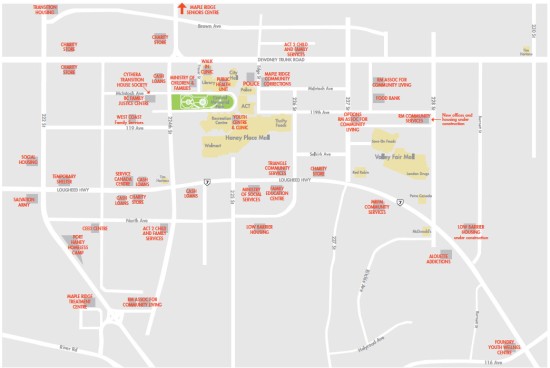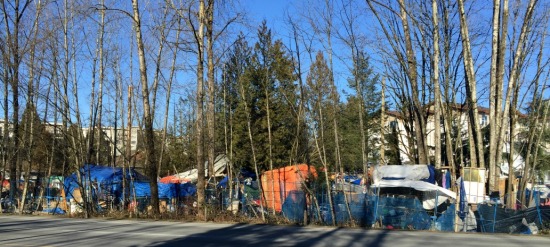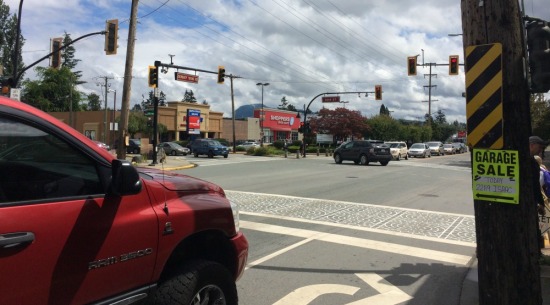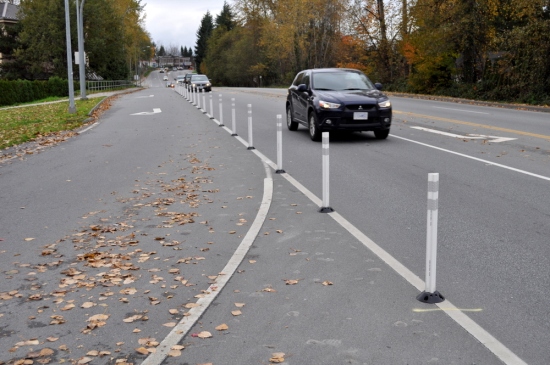
Services available for low-income people, seniors and families in trouble in downtown Maple Ridge, summer 2019. This may not be the complete list. (Graphic by Farnsworth Designs.)
Like some other sprawling urban jurisdictions in British Columbia’s Lower Mainland, Maple Ridge (population 80,000) has a downtown core built around an old rural crossroads. The construction of the Lougheed Highway through farmland in 1929 generated a commercial cluster at the intersection of 224 Street. The original Fuller Watson furniture store is still in business at this corner, and other 1929-era structures nearby are home to newer retail businesses such as the gelato store and a micro-brewery.
There is money in Maple Ridge. The 2016 Canada census indicates the median income is relatively high — well above those in the City of Vancouver, Burnaby, Surrey, Coquitlam or Richmond. Managers and professionals commute from Maple Ridge to downtown Vancouver, the International Airport or the North Shore, online entrepreneurs and investors generate millions from their hillside estates, and double-income couples work in public-sector positions as university teachers, school teachers, nurses, bus drivers, municipal officials, police officers and prison guards. The money from these government jobs is not always spectacular, but it is steady and it comes with generous pensions.
Of course, there are lower-income people too. Many have settled in apartment complexes north or east of City Hall, where the can walk to buy groceries or to catch a bus. Some once worked in the lumber mills and factories that have disappeared over time; others have emerged a Maple Ridge jail without skills or aptitudes; the largest number, doubtless, work at a low wage in the hair salons, dollar stores and for-cash contracting businesses that form a big part of the local private-sector economy.
In a dynamic that has rolled out over many years, Maple Ridge has also spawned or attracted a prominent homeless population. For the B.C. news media, homelessness is a big part of the Maple Ridge brand; and for many local political candidates, homelessness became almost the sole issue in the 2018 municipal election campaign.
Other cities in the region — Abbotsford, Chilliwack, Surrey and New Westminster, for starters — also struggle with homelessness and related problems such as public drug use and property crime. However, it may be that the homeless are more visible in Maple Ridge than anywhere else, partly because the city’s founding families (think 1929) still own much of the inner-city land and have left it vacant.

The Port Haney homeless camp, Maple Ridge, on March 3, 2019, just after the City of Maple Ridge ordered residents to evacuate. In the next few days, 400 cubic metres of refuse were removed from an area the size of a standard residential lot. The City eventually allowed registered residents to return to the camp, under heavy security, but refused to admit any new campers. As as of summer 2019, the population had dwindled to something like 8 residents, down from a peak of 60 or more. The homeless, however, are still visible on the street, and appear to be scattered to gullies and the Fraser River shore.
Scored on the Fraseropolis urban villages index, devised for middle-class city dwellers such as myself, downtown Maple Ridge scores in the low to mediocre range. There is housing choice within 750 metres of the main streets, the transit system is improving, and there is growing urban interest around the farmer’s market. On the negative side, the retail and commercial services sprawl across too wide an area to encourage walking, the retail quality is often low, and retail businesses and restaurants frequently fail.
I developed the map at the top of this post simply on a hunch, to see what it would look like. My 2012 Fraseropolis index does not consider the density of social services — for the very poor, families in trouble, or low-income seniors. This is not a dimension of urban life that business improvement associations or local newspapers have focused on. However, the availability of such services is critical in pointing people towards employment, healthier choices and affordable housing. In exploring the urban villages of B.C. since 2012, I have frequently sensed a conflict between the need for social services storefronts and the consumer appetite for the chic and the trendy. The challenge, I guess, is to integrate services for the poor into trendy neighbourhoods; or alternatively, to think of ways to eliminate poverty.

Dewdney Trunk Road at 224 Street, Maple Ridge. Some visitors to the downtown may be driving in to shop in one of the strip malls, take a yoga class or have their truck repaired; others may be walking from apartments nearby to see their probation officer or negotiate free clothing at a charity store.



